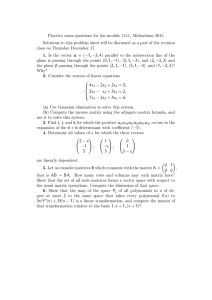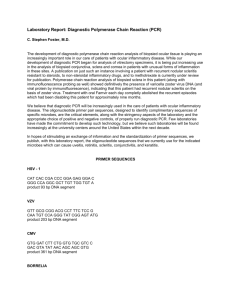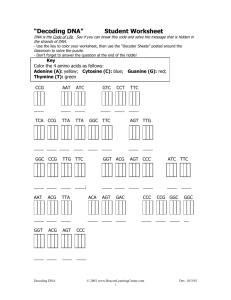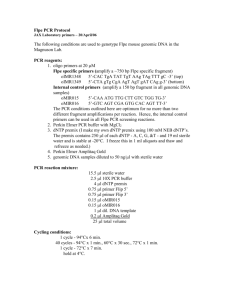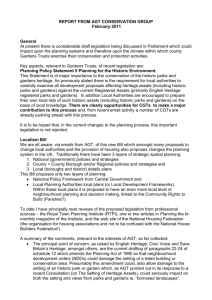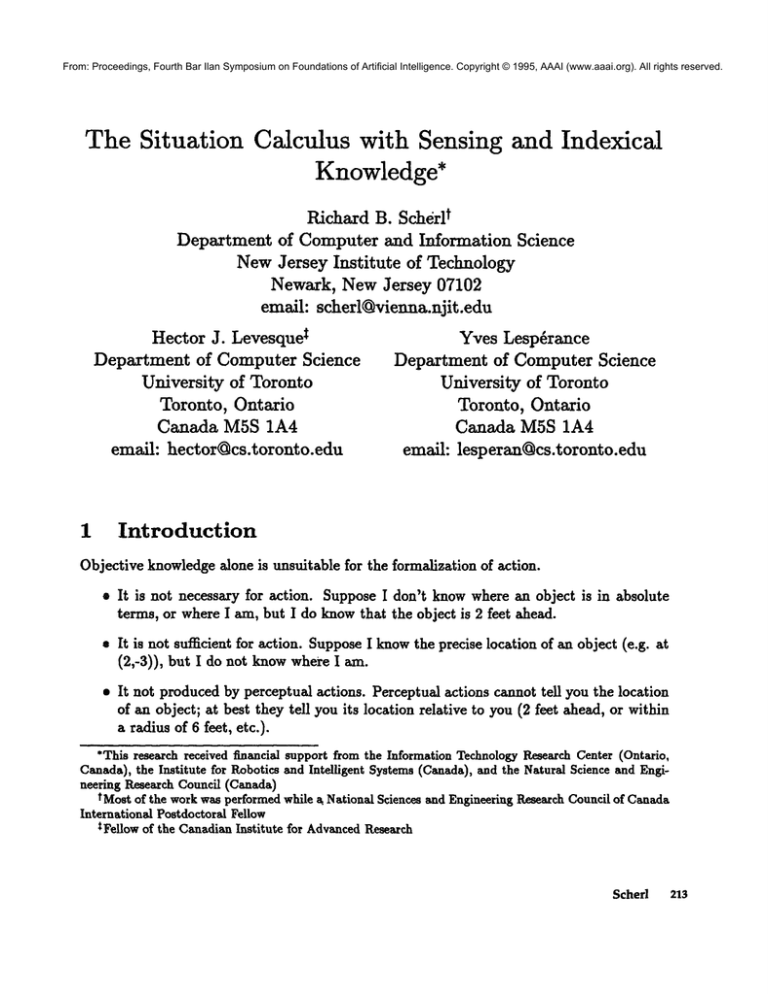
From: Proceedings, Fourth Bar Ilan Symposium on Foundations of Artificial Intelligence. Copyright © 1995, AAAI (www.aaai.org). All rights reserved.
The Situation Calculus with Sensing and Indexical
Knowledge*
tRichard B. Scherl
Department of Computer and Information Science
NewJersey Institute of Technology
Newark, New Jersey 07102
emaih scherl~vienna.njit.edu
$Hector J. Levesque
Department of Computer Science
University of Toronto
Toronto, Ontario
Canada M5S 1A4
emaih hector~cs.toronto.edu
1
Yves Lesp~rance
Department of Computer Science
University of Toronto
Toronto, Ontario
Canada M5S 1A4
emaih lesperan~cs.toronto.edu
Introduction
Objective knowledge alone is unsuitable for the formalization
of action.
® It is not necessary for action. Suppose I don’t know where an object is in absolute
terms, or where I am, but I do know that the object is 2 feet ahead.
s It is not sufficient for action. Suppose I know the precise location of an object (e.g. at
(2,-3)), but I do not know where I
¯ It not produced by perceptual actions. Perceptual actions cannot tell you the location
of an object; at best they tell you its location relative to you (2 feet ahead, or within
a radius of 6 feet, etc.).
*This research received financial support from the Information TechnologyResearch Center (Ontario,
Canada), the Institute for Robotics and Intelligent Systems(Canada), and the Natural Science and Engineering Research Council (Canada)
tMost of the workwas performedwhile ~ National Sciences and Engineering ResearchCouncil of Canada
International Postdoctoral Fellow
Fellow of the CanadianInstitute for AdvancedResearch
Scherl
213
From: Proceedings, Fourth Bar Ilan Symposium on Foundations of Artificial Intelligence. Copyright © 1995, AAAI (www.aaai.org). All rights reserved.
Whatmatters in these examplesis not the objective locations of objects, but their locations
relative to the robot. Weneed to be able to express indezical information, i.e. information
about the world relative to a context--without having to identify these objectively. Examples
are me, my location, my orientation, the current time, and the object in my sights. The
importance of such indexical representations in the area of robotics has been pointed out in
[Agre and Chapman, 1990].
This paper develops a version of the situation calculus that incorporates the notion of
indexical knowledge.It is part of a larger endeavor, the cognitive robotics project, whichuses
the situation calculus as the basis of both a higher level programminglanguage for agents,
and a logical theory of the integration of reasoning, action, and perception [Lesp&anceet
al., 1994; Lesp&anceet al., 1995].
With the representational framework developed here, the knowledge prerequisites and
effects of actions can be specified in terms of indexical rather than objective knowledge.The
problem includes howto represent information such as the knowledgeof relative positions
and relative effects of actions, howto modelthe lack of knowledgeof one’s ownidentity, and
how to model knowledge of time.
These issues are considered in a modal framework in [Lesp&ance and Levesque, 1995].
Here, these notions are incorporated into the situation calculus. This is done in such a way
as to utilize the solution to the frame problemfor knowledgeproducing actions developed in
[Scherl and Levesque, 1993] where only objective knowledgeand a single agent are considered.
Additionally, a computationally attractive method is developed for answering queries of
whether or not a particular sentence is true in the state resulting from the execution of a
particular sequenceof actions.
2
The Situation
Calculus
and the Frame Problem
The situation calculus is a first-order language for representing dynamicallychanging worlds
in which all of the changes are the result of namedactions performed by someagent. Terms
are used to represent states of the world-i.e, situations. If a is an action and s a situation,
the result of performinga in s is represented by do (ct, s). The constant So is used to denote
the initial situation. Relations whosetruth values vary from situation to situation, called
fluents, are denoted by a predicate symbol taking a situation term as the last argument.
For example, BROKEN
(z, s) means that object z is broken in situation s. Functions whose
denotations vary from situation to situation are called functional fl’uents. Theyare denoted
by a function symbol with an extra argument taking a situation term, as in POS(BILL, S),
which denotes the position of BILL in situation s.
One of the longstanding problems connected with the situation calculus has been the
frame problem, i.e., the need to add frame azioms that specify when fluents remain unchanged. Reiter [1991] (generalizing the work of Haas, Schubert, and Pednanlt) proposed
solution to the frame problem. In this presentation, the formulation found in [Reiter, 1991]
is generalized to a multi-agent context.
A simple example domain will be used throughout this paper. There are some numberof
214
BISFAI-95
From: Proceedings, Fourth Bar Ilan Symposium on Foundations of Artificial Intelligence. Copyright © 1995, AAAI (www.aaai.org). All rights reserved.
robots who move about on a two-dimensional grid. A relational
fluent (HOLDING)is needed
to indicate whether or not a particular robot is holding an object and functional fluents
are needed to denote the position (POS) of robots (and other objects) and the orientation
(oaI) of the robots. The idea here is to imagine that these robots can perform a limited
number of primitive actions that are inherently indexical. These (following [Lesp~rance and
Levesque, 1995]) are picking up an object, putting down an object, moving forward one step,
turning 90° to the left, turning 90° to the right, and sensing whether an object with certain
properties is at his location.
To treat multiple agents, we will take the first argument of do to be a pair consisting of
an agent and an action type. The variable a below ranges over such pairs. The function
AGENT(a) is used to map a to the agent component and the function TYPE(a) is used
map a to the action type component. Action types are represented as strings of characters.
For our example, the action types are "pickup", "putdown", ~forward", ~left", and Uright".
This differs from our earlier work [Scherl and Levesque, 1993] and the work of Reiter [1991],
in which the variable a ranged over terms denoting actions.
The core of the solution to the frame problem rests on providing for each fluent a successor
1.
state axiom of the form given below
Successor
State Axiom
FCdo(a,
))
v
^
(1)
Here 7+(a, s) represents the conditions under which the truth value of F will change from
negative to positive and "L~(a, s) represents the conditions under which the truth value
F will change from positive to negative. Similar successor state axioms may be written for
functional fluents. Reiter[1991] shows how to derive a set of successor state azioms of the
form given in 1 from the usual axiomatization in terms of positive effect and negative effect
axioms, along with unique name axioms and a completeness assumption.
The successor state axioms for the fluents HOLDING,
POS, and ORI are given below.
HOLDING(
ag%, z, do(a, s)
(OBJECT(Z,S) POS(ag~,s)= POS(z,s) A
-~ 3yHOLDING(agt,y,s)A
TYPE(a) -- "pickup" A AGENT(a) ag~) V
(HOLDING(agt, x, s)
(TYPE(a) ~ "putdown" V AGENT(a) ~
(2)
This axiom states that the only way for the fluent HOLDING
to be true of actor agt and
object x in situation do(a, s), is if in situation s either agt is located in the same position as
the object z, is not holding anything, and the action a is the execution of a "pickup" type
1Unlikethe presentation in [Reiter, 1991; Scherl and Levesque,1993], here wedo not use a£tion precondition axioms. The use of such axiomsand the Poss predicate is perfectly consistent with the approachhere,
but unnecessaryfor the types of examplesthat weare considering.
This discussionassumes(following [l~iter, 1991])that there are no ramifications, i.e., indirect effects
actions. The assumptionthat there are no state constraints in the axiomatization of the domainwill be
madethroughoutthis paper. In [Lin and Reiter, 1994], the approachdiscussed in this section is extendedto
workwith state constraints by compilingthe effects of the state constraints into the successorstate axioms.
From: Proceedings, Fourth Bar Ilan Symposium on Foundations of Artificial Intelligence. Copyright © 1995, AAAI (www.aaai.org). All rights reserved.
action by agt; or agt is holding x in situation s and either the agent of action a is an actor
other than agt, or the action type of a is a type other than "putdown."
POS(~,do(a,s))
=
(x = AGENT(a)
V(OsJECT(x)
^ HOLDING(AGENT(a),~,s)))
^ TYPE(a) = "forward"
POS(AGENT(a,~))
= (l-- ((1,0) XaOT(OaI(AGENT(a),
(POS(X,
S) --
l ^ (TYPE(a)
(3)
"f orward" V
(AGENT(a)
# ¯ A--HOLDING(AGENT(a),~,,)))
The following is the definition of ROT:
ROT(O)
sinS)
=def{
- sinCOS0
8 cos
8
This axiomstates that for POSof an object x in situation do(a, s) to be equal to l, it must
be the case in situation s that either x is a robot or somethingbeing held by a robot, x was
located i unit behind l and the action a is an execution of action type "forward" by x or
the robot holding x; or x was located at I and the action a is not the execution of the action
type "forward" by x or some robot holding x.
oR,(~,do(a,s))=
(X -~ AGENT(a) A TYPE(a) "l eft" A ORI(x, 8)
-- MOD
2~r(8 -~r/ 2)) V
(x ---- AGENT(a) ^ TYPE(a) -- "right"
A ORI(x,S) = MOD27r(0 "b 7r/2))
(ORI(x,s)
-’0
^ (TYPE(a)
"l eft"
A TYPE(a) ¢
(4)
"right") V
AGENT(a)
~)
This axiomstates that for the orientation of robot x to be 0 in situation do(a, s) it must have
been the case in situation 8 that either the orientation was 0 + ~’/2 and a is the execution of
action type "left" by x; or the orientation was 0 - r/2 and a is the execution of action type
"right" by x; or the orientation was 0 and a is not the execution of "left" or "right" by x.
Wehave developed a set of macros for specifying complexactions that are abbreviations
for formulasin the situation calculus. Spaceprecludes their presentation here, but it is fully
developed in the longer version of this paper. Movingto a particular objective location or
relative location can then be specified as a complexaction in this macrolanguage.
3
Indexical
Knowledge
The approach we take to formalizing indexical knowledgeis to adapt the possible-world model
of indexical knowledgeof [Lesp&anceand Levesque, 1995] to the situation calculus, much
as Moore[1985]adapted the possible-world model of knowledgeto the situation calculus.
It will be assumedhere that agents are awareof all actions, i.e., every action occurrence
is commonknowledge. But, consistent with the indexical logic of knowledge and action,
although actors knowthat the agent of a particular action is denoted by a particular term,
they will not necessarily know who that agent is. An actor may know that he himself
216
BISFAI-95
From: Proceedings, Fourth Bar Ilan Symposium on Foundations of Artificial Intelligence. Copyright © 1995, AAAI (www.aaai.org). All rights reserved.
performed an action, without necessarily knowingwhohe is. Similarly, an actor mayknow
that the block was movedby the person on his left, without necessarily knowing who the
person on his left is.
A 4-place relation K(agt’, s’, agt, s) is introduced. This is understood as indicating that
it is compatible with art’s knowledgein s that the current situation is s’ and he is art’. The
predicate K is treated the same way one would any other fluent.
Weuse the notation Knows(A, P(now),s) (read as A knows P in situation s)
abbreviation for a formula that uses K. For example:
Knows(gOB,
BROKEN(y,
now), s) Vagt’, s’ g (agt’, s’, ROB,
s) -- ~ BROKE
N(y, s’).
Note that this notation substitutes the appropriate situation argument for nowon expansion.
This notation can be generalized inductively to arbitrary formulas so that, for example2:
Bz Knows(ROB,3y[NEXTTO(z,y, now) A -,Knows(ROBESTA,BROKEN(y,now), now)],
a=d3zVagt’, s’ K(agt’, s’, ROB, 8) ~ 3y[NEXTO(z,
y, s’)
-V agt",s"g(agt",
s",ROBERTA,S’) --* BROKEN(y,S")].
Wealso introduce the notation self as illustrated
in the following example:
Knows(ROB,
NEXTTO(seIf,y, now), s) d_d
V afft’, s’ K(agt’, s’, ROB,s) --~ NEXTTO(agt’,
y, s’).
The convention is that self is replaced by the leftmost argument of K, whenit (self) occurs
within a literal not in the scope of another K. Consider the following example:
Knows(ROB,
3y[NEXTTO(self,y, now) A -~Knows(self, NEXTTO(self,y, now), now)],
d~ Vagt’, s’ K(agt’, s’, ROB,s) ~ 3y[NEXTTO(agt’,y, s’)A
-~Vagt",
saK(agt",8",agt’,8’) -’-’,
NEXTTO(agt",
y, aa)].
The term self can only be used within the scope of a Knowsoperator.
Turning nowto the specification of the effects of knowledge-producingactions, consider
actions whose effect is to make knownthe truth value of some formula3. Wemight have a
"sense.." action for a sentence c~, such that after doing a ~sensea", the agent comesto know
whether c~ holds. Weintroduce the notation Kwhether(agt, c~, s) as an abbreviation for
formula indicating that the truth value of sentence a is known:
Kwhether(agt,c~, s) d___dKnows(aRt,
cx, 8) V Knows(aRt,
-~c~,
By adding a fluent TIME(8) representing the absolute time of a situation, we can also
handle objective knowledge about time, indexical knowledge about time, and knowledge of
the relation between indexical and objective notions of time (e.g. knowingthat it is now
3:00). Full details are in the extended version of this paper.
aThe predicate NEXTTO
can be defined in terms of Pos.
STheresults reported here can easily be extended, following [Scherl and Levesque, 1993], to incorporate
a ’~read" type action that makes knownthe denotation of a term.
Scherl
217
From: Proceedings, Fourth Bar Ilan Symposium on Foundations of Artificial Intelligence. Copyright © 1995, AAAI (www.aaai.org). All rights reserved.
4
Solving
the Frame Problem for Knowledge
The extension of Reiter’s [1991] solution to the frame problemto the situation c~culus with
indexical knowledgerests on the specification of a successor state axiom (following [Scherl
and Levesque,1993]) for the four-place Krelation. For all situations do(a, 8), the K relation
will be completely determined by the K relation at 8 and the action a. The successor state
axiom for K will first be introduced by stages. Consider the simple situation where there
are only two actors and each refers to the other with the term OTHER(self,8)4. It is assumed
that OTaERis axiomatized in such a way that OTHER(ag$,
8) ~ agt. First we will consider
what effect ordinary actions will have on the K relation and then we will give a specification
for the case where there is only a single knowledge-producingaction. In the discussion to
follow, for conveniencethe notation (agt, type) is used to represent pzfirs of agents and action
types.
For non-knowledge-producingaction types (e.g. "pickup"), the specification (based
Moore[1985]) is as follows:
K ( agt", 8", agt’, do( (agt, "pickup"),8) =
3s’ K(agt", s’, agt’, s) A 8" = do(a*, 8’) A TYPE(a*) = "pic kup" A
(agt’ = agt -~ AGENT(a*)agt’)
(5)
A
(agt’= ozaEa(agt,8)
-+ AGENT(a’)
= OTKrR(agt",8’))
The axiom ensures that if agf = agt, the only change in knowledgethat occurs in moving
from s to do((agt, "pickup"),8) is the knowledgethat the action type "pickup" has been
performed by itself. But if agt’ is not the agent of the action, then the only change in
knowledgethat occurs in movingfrom 8 to do((agt, "pickup"), 8) is the knowledgethat the
action type "pickup" has been performed by the other robot. Note that this does not require
the agent to knowwhohe is or whothe other agent is.
Nowconsider the simple case of a knowledge-producingaction type "sense/," that determines whether or not the fluent P is true (following Moore[1985]).
K( agt", 8", agt",do({ agt, "sense~,",8)))
38’ K(agt", 8’, agt’, 8) A 8" = do(a*, 8’) A 3a* TYPE(a*) "sense/," A
(agt’= agt-~(AGENT(a’)
= agt"
,’, P(,)-- P(~’)))
^
(agt’
(6)
= OTHER(agE, s) ~ AGENT(a*) OTaER(agt",8))
The idea here is that in the case where agt’ is the agent of the action, after performing the
action agE’ not only knowsthat the action type "sense/," has been performed, and that he
has performed it (as above), but also the truth value of the predicate P. Onthe other hand,
iff agt’ ~ age then in movingfrom 8 to do((agt, "sense/,"), 8), agt’ knowsonly that the action
type "sensep" has been performed, and OTHER
has performed it, but he does not knowthe
truth value of the predicate P.
4The simplest option is chosen here. Issues with regard to naming agents are discussed in [Lesp6ranee
and Levesque, 1995].
218
BISFAI-95
From: Proceedings, Fourth Bar Ilan Symposium on Foundations of Artificial Intelligence. Copyright © 1995, AAAI (www.aaai.org). All rights reserved.
Poss(a,s)
~ [K(agt",s",agt’,do(a,s))
3s’ K(agt",s’,agt’,s)
A s" "-do(a*,s’)
A 3a* TYPE(a*)--TYPE(a)
t
(ag~ -- AGENT(a) --+ (AGENT(a*) -- agt ~ A
(TYPE(a)
A
A
(TYPE(a)-" .~ --+ ~pn))A
(agt’ ~- OTHERI(AGENT(a),s) ~ AGENT(a*) -" OTHEKl(agtn,~t))
A
A
(agt t -- OTHERM(AGENT(a),s) -~+ AGENT(a*) "- OTHERM(ag~tt, st))
Figure 1: Successor State Axiomfor K
Observethat the successor state axiomfor P guarantees that P is true at do((agt, "sensep"), s)
iff P is true at s, and similarly for s’ and do((agt, ~sensep~), s’). Therefore, P has the
sametruth value in all worlds s" such that K(agt", s",agt’, do((agt, "sensep’), s)), and so
Kwhether(P, do((agt, ~sensep’), s)) is true.
In general, there may be many knowledge-producing actions. Associated with each
knowledge-producingaction .Ai is a formula of the form ~i(s) = ~i(s’), where ~i is a sentence. Assumethat there are n knowledge-producing actions .A1,...,,4,
and therefore n
associated sentences ~bt,..., ~,,. Additionally, other than the agent of the action a, there are
n other actors-OTItEa~(agt, s)... OTHSa=(agt,s). The general form of the successor state
axiom for K is given in Figure 1.
The only remaining issue concerns requiring that the Knowsoperator conform to the
properties of a particular modal logic. Restrictions need to be placed on the K relation
so that it correctly models the accessibility relation of a particular modal logic. This issue is discussed in [Scherl and Levesque, 1993]. The solution is to utilize a sort lnit to
restrict variables to range only over So and those situations accessible from So. Then the
K relation is appropriately restricted over these initial situations. The needed restrictions
(following [Lesp~ranceand Levesque, 1995]) are reflexivity and transitivity. Full details
the axiomatization of these restrictions is found in the extended version of this paper.
5
Properties
of the Solution
Note that even though the logic is a variant of $4, Sentence 7 is not a theorem of the logic.
Knows(aoB, P(now)) ~ Knows(ROB,Knows(aOB, P(now), now),
On the other hand 8 is a theorem.
(7)
Knows(ROB,P(now)) ~ Knows(ltoB, Knows(self, P(now), now),
(8)
Scherl
219
From: Proceedings, Fourth Bar Ilan Symposium on Foundations of Artificial Intelligence. Copyright © 1995, AAAI (www.aaai.org). All rights reserved.
It is not the case that if ROBknowsP he then knowsthat ROBknowsP, but rather he knows
that he knows P.
It is also necessary to showthat actions only affect knowledgein the appropriate way. The
truth of the following theorem ensures that there are no unwantedincreases in knowledge.
Theorem 1 (Default Persistence of Ignorance)
~Knows(AGT, P(now), do(a, s)), as long
/f--,Knows(AGW, P(now), s) then
1. P is a fluent whosesuccessor state axiom specifies that it is not changedby the action
TYPE(a). More formally, Vs, a TYPE(a)= TYPE(a)P(s) =-- P(do(a,s))
2. It is not the case that both AGT= AGENT(a) and TYPE(a) is a knowledge-producing
action with the corresponding ¢p being of the form F(s) F(s’) such th at ei ther
F(s) and Knows(AGT, F(now)~ P(now),s) or’~F(s) and Knows(AGW,-~F(now)
P(now),
Finally, it is a property of this specification that agents never forget.
Theorem 2 (Memory) For all fluents P and situations s, ifKnowS(AGT, P(now), s) then
KnowS(AGT,
P(now), do(a, s) ) as long as P is a fluent whosesuccessor state axiom specifies
that it is not changedby the action TYPE(a).
Nowconsider the following sentences:
Knows(ROB,[3xOBJ(x) ^ POS(z, now) = POS(self, now)^
~3yHOLDING(y,
now)], So)
3pp = POS(self, So) ^ Knows(SOB,[3xOBJ(x) ^ POS(x, now)
A~3yHOLDING(y,now)], So)
Knows(ROB,3yHOLDING(y,now), do((ROB, "pickup"),
(9)
(10)
(11)
Our axiomatization entails that:
(9) ---. (11) If ROBknowsthat there is an object wherehe is, then after doing pickup,
will be holding something.
(I0) ---* (11) If SOBknowsthat there is an object at some location and that location
happens to be where he is, then he need not knowthat he would be holding anything after
doing a pickup action.
Additional properties are found in the extended version of the paper.
6
Reasoning
Given the representation of actions and their effects, we would like to have a method for
addressing the projection problem. This is the question of determining whether or not some
sentence G is true in the situation resulting from the execution of a sequence of ground
action terms.
Following [Reiter, 1991; Scherl and Levesque, 1993] regression is used to reduce reasoning
about future situations to reasoning about the initial situation. So given a plan, expressed
220
BISFAI-gS
From: Proceedings, Fourth Bar Ilan Symposium on Foundations of Artificial Intelligence. Copyright © 1995, AAAI (www.aaai.org). All rights reserved.
as a ground situation term (i.e. a term built on So with the function do and ground action
terms) sg~, the question is whether the axiomatization of the domain.~" entails G(sar) where
G is an arbitrary sentence. Under these circumstances, the successor state axioms are only
used to regress the formula G(sar). The result of the regression is a formula in a modallogic
of indexical knowledgci.e. a formula where the only situation term is So.
Wehave the following theorem, where ~" is the axiomatization of the domain including
~’,, the successor state axioms. The theorem shows that reasoning with the successor state
axioms need only be done with regression. The notation X~(~) is used to indicate that
the regression operator is applied repeatedly until further applications leave the formula
unchanged.
Theorem 3 For any ground situation
term sa~
Both the axiomatization of the initial situation and the regressed formula are expressions in
a logic of indexical knowledge. The entailment test can be performed either by translating
the sentences into first-order logic and using an ordinary theorem prover or moreefficiently
by using a theorem proving method for the indexical logic of knowledge. Wehave developed
such a method based on the frameworkin [Frisch and Scherl, 1991]. Full details appear in
the longer version of this paper.
The steps of the regression operator for fluents other than knowledgeare the same as
those found in [Reiter, 1991; Scherl and Levesque, 1993]. Steps v and vi, for knowledge,
are given below. Twodefinitions are needed for the specification to follow. When~ is
an arbitrary sentence and s a situation term, then ~[s] is the sentence that results from
substituting s for now throughout ~, but not within the scope of a Knowsoperator. The
reverse operation ~-1 is the replacement of those situation variables that are not within the
scope of a Knowsoperator by now.
In the definitions below, sr is a newsituation variable.
v. Whenevera is not a knowledge-producing action,
Re [Knows(a#t,IV, do(a, s))] = Knows(agt, 7~0[W[do(a,s’)]]-’,
s ).
vi. Whenevera is a knowledgeproducing action and ct~ is the corresponding sentence in the
successor state axiom for K
7~o[Knows(agt,W, do(a, s) =
(AGENT(a)~-agt A ((~i(s)~ Knows(agt,~i--~ 7?~[W[do(a,s~)]]-l,s))
^ (-~i(s) ~ Knows(agt,-.~i ~ 7~e[W[do(a,s’)]]-l,s)))
V (AGENT(a)agt ^ Knows(agt, ~o[W[do(a,s’)l]-~,s))
Here the methodis only illustrated
the following:
with the exampleof Sentence 11. It is regressed to
Knows(ROB,3y OBJ(y) pos(self, no w) = POS(y, now)
A -~3~;HoLOING(x,
now)),
It can be verified that that Sentence 9 ~ 12, while Sentence 10 ~= 12.
(12)
Sched
~1
From: Proceedings, Fourth Bar Ilan Symposium on Foundations of Artificial Intelligence. Copyright © 1995, AAAI (www.aaai.org). All rights reserved.
7
Summary and
Future
Work
Knowledgeproducing actions such as sensing typically yield indexical knowledge, which is
exactly what agents require to knowwhat actions to perform to achieve their goals. Wehave
extended the situation calculus with knowledgeof [Scherl and Levesque, 1993] to deal with
this feature of commonsensereasoning. In doing so, we have preserved the solution to the
frame problem and adapted the regression method for reasoning about the effects of action
to cope with indexical knowledge.
In this paper the assumption was madethat all agents are aware of all actions carried
out by other agents. Relaxing this assumption is being addressed in our current research.
Other topics are developing methodsfor synthesizing plans that include sensing actions, as
well aa applications in robot programming.
References
[Agre and Chapman, 1990] Agre, P. E. and Chapman, D. 1990. What are plans for? Robotics and Autonomous Systems 6:17-34.
[Frisch and Scherl, 1991] Frisch, Alan and Scherl, Richard 1991. A general frameworkfor modal deduction.
In Alien, J.A.; Fikes, R.; and Sandewall, E., editors 1991, Principles of KnowledgeRepresentation and
Reasoning: Proceedings of the Second International
Conference, San Mateo,CA : Morgan Kaufmann.
196-207.
[Lespdrance and Levesque, 1995] Lespdrance, Yves and Levesque, Hector 1995. Indexical knowledge and
robot action--a logical account. Artificial Intelligence 73(1-2):69-115.
[Lespdrance et al., 1994] Lesp&ance, Yves; Levesque, Hector; Lin, Fangzhen; Marcu, Daniel; Reiter, Ray;
and Scherl, Richard 1994. A logical approach to high-level robot programming -- a progress report.
Appears in Control of the Physical World by Intelligent Systems, Working Notes of the 1994 AAAIFall
Symposium, New Orleans, LA.
[Lespdrance et al., 1995] Lespdrance, Yves; Levesque, Hector 3.; Lin, F.; Marcu, Daniel; Reiter, Raymond;
and Scherl, Richard B. 1995. Foundations of a logical approach to agent programming. To appear in
Proceedings of the HCAI-g5Workshop on Agent Theories, Architectures, and Languages.
[Lin and Reiter, 1994] Lin, Fangzhen and Reiter,
Logic and Computation 4(5):655-678.
Raymond1994. State constraints
revisited.
Journal of
[Moore, 1985] Moore, R.C. 1985. A formal theory of knowledge and action. In Hobbs, J.R. and Moore,
R.C., editors 1985, Formal Theories of the CommonsenseWorld. Ablex, Norwood, NJ. 319-358.
[Reiter, 1991] Reiter, Raymond1991. The frame problem in the situation calculus: A simple solution
(sometimes) and a completeness result for goal regression. In Lifschitz, Vladimir, editor 1991, Artificial
Intelligence and Mathematical Theory of Computation: Papers in Honor of John McCarthy. Academic
Press, San Diego, CA. 359-380.
[Scherl and Levesque, 1993] Scherl, Richard B. and Levesque, Hector J. 1993. The frame problem and
knowledgeproducing actions. In Proceedings, Eleventh National Conference on Artificial Intelligence.
689-695.
222
BISFAI-95

